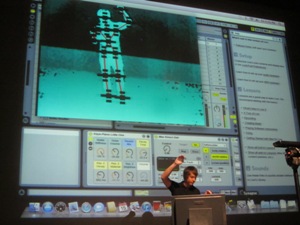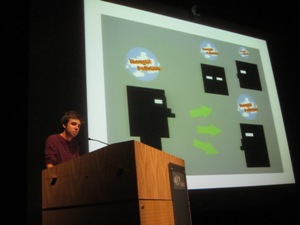Graduating seniors show off high-tech projects at 'Best of ICAM'
By Claire Discenza
San Diego, Calif., June 25, 2012 — For his senior project, University of California, San Diego Interdisciplinary Computing and the Arts (ICAM) major Travis Thompson designed a program that turns a person into a musical instrument. Standing before an audience at 12th annual “Best of ICAM” presentations at the California Institute for Telecommunications and Information Technology (Calit2), Thompson created electronic music simply by shifting the position of his limbs. Through camera tracking, these motions varied the pitch, rhythm, and quality of the music.
|
The ICAM program is both a major and a minor within the Music and Visual Arts departments at UC San Diego. Around two-dozen seniors were selected by faculty recommendation to present their senior projects earlier this month, either at the Mandeville Annex Gallery or on the media stage at Calit2.
“The senior project is really meant to be a transition from student- to professional-work,” said ICAM advisor Peter Otto. “And this [the students’ work] is all Hollywood quality.”
The ICAM major aims to prepare the next generation of artists with the technical skills and the theory to work, design and develop their art within a computer-mediated culture.
“Our ICAM students are a special group,” said Otto. “The cool thing about ICAM is that our students are actually inventing the field that they are going to participate in.”
The “Best of ICAM” presentations spanned a wide range of topics, and used many different media and technologies.
Among the presenting students was Timothy Stein, with his “Thought Pollution” project. Stein designed an on-campus movement based on nothing at all. He would sit outside at an official-looking booth with a purposeless “Thought Box” and uninformative pamphlets, recruiting new members. Thinking that they understood what was going on, UC San Diego students would end up defining what Thought Pollution meant to them on an individual basis.
“I learned that people at UCSD want a place to share really weird ideas,” said Stein. “I feel by the end I’d started grasping what the project was.”
|
Another senior, Matthew Shulman, studied low-frequency spatialization or the directing of very deep sounds. For his project, Shulman experimented with an “End-Fire Array,” or a line of carefully-spaced subwoofers, systematically testing their ability to constructively interfere to create directed sound. Such a system would be useful in concerts, where an artist might want to point music away from the stage and toward the audience.
Jessica Wu’s project, titled “Child’s Play,” is an interactive comic video game in which the goal is to save a hospitalized child through adventures through fantasy worlds. The game, along with others, can be played to raise money for children’s charities.
“For me personally, it was to bring about a more positive light on gamers,” explained Wu. “Children feel very uncomfortable in hospitals. You as a player are basically here to save this kid. It’s giving back to the community.”
Other students focused on composing digital symphonies, recording and presenting surround-sound musical performances, and sharing history and current events creatively online.
“I think it’s a highly visionary and highly inspired field to be working in,” said Otto. “Every one of our ICAM seniors is going to be a leader in an emerging field that has to do with the internet, digital media, new kinds of visualization, and new kinds of ways of working with music.”
Besides showcasing student work, “Best of ICAM” offered parting words of wisdom to those graduating from the program. In a keynote address presented on a theater-sized screen, Tiffany Hopkins, ICAM ‘07, gave her encouragement to aspiring digital artists and musicians heading out to create something new in the world.
“As we all know in ICAM, we aren’t one thing. We’ll always be artists/musicians/scientists/businessmen,” said Hopkins. “This is what ICAM is about. Nobody has done this before — it’s new. And that’s amazing.”
Media Contacts
Story by Claire Discenza
Media contact: Tiffany Fox, tfox@ucsd.edu, (858) 246-0353
Related Links



